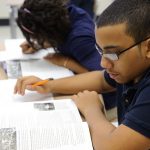“Betsy DeVos’ appointment as the U.S. secretary of education was controversial, but it seems appropriate one year into her tenure to emphasize the opportunities that lie ahead for education,” says Shaun Dougherty, an assistant professor of education and public policy at the University of Connecticut. “One such opportunity that has bipartisan support and the potential for positive impacts is the reauthorization of the Carl D. Perkins Career and Technical Education Act, first signed into law in 1984 and last reauthorized in 2006.”
Neag School alumna Dr. Laurie Henry has been appointed the next dean of Salisbury University’s Seidel School of Education.
Joshua Hyman, a researcher at the University of Connecticut, studied the effects of mandatory ACT tests in Michigan’s public high schools and found that the policy led to many more low-income students not only taking the test, but performing well.
The Maurice Sendak Collection will be an invaluable resource for UConn undergraduate students in English, Creative Writing, Art and Art History, the Neag School of Education, and Psychology, as well as our graduate students and visiting scholars.
NPR (Neag School professors and a student weigh in on arming school staff in response to the school shootings)
UConn’s baseball coach, Jim Penders, is the prime example of a coach who is very high on player development and the numbers don’t lie. Under his belt are numerous appearances in the NCAA tournament including a Super Regional appearance in 2011, three conference titles and a total of 43 players either drafted or signed by professional baseball clubs.
According to Neag School psychology researchers James Kaufman and Ronald Beghetto, little-c creativity has been useful for addressing common misconceptions about creativity.
UConn gifted education specialists have published the first study to demonstrate a link between student poverty, institutional poverty, and the lower identification rate of gifted low-income students.
“This is the first look at this issue in a significant way,” says Rashea Hamilton, a research associate in the National Center for Research on Gifted Education (NCRGE), part of UConn’s Neag School of Education. “We were able to make connections between higher proportions of free or reduced lunch students and availability of gifted programs and percentage of gifted students.”
Can we train an athlete to make them look like, seem like, act like a hummingbird? Probably not,” Jaci VanHeest said. But, she speculates, with some cellular or genetic tweaks, “can we get more than 4%? Maybe.”

